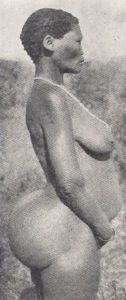
Saartjie Baartmangravesite in South Africa
*This date celebrates the birth of Saartjie Baartman, who was born in 1789. She was a South African entertainer and objectified Black woman.
Saartjie Sarah Baartman was born in the Gamtoos Valley of South Africa. She was orphaned in a commando raid. Baartman may have been a slave of a Dutch farmer named Peter Cezar near Cape Town, which had recently come under British control. Cezar's brother, Hendrik, took an interest in Baartman while visiting his farm and, together with Alexander Dunlop, a military surgeon with a sideline in supplying showmen in Britain with animal specimens, suggested she travel to England for exhibition. Lord Caledon, governor of the Cape, permitted the trip but later regretted it after he thoroughly learned the purpose of the trip.
She left for London in 1810 in her 20s, an enterprising Dunlop, accompanied by Hendrik Cesars, who sold her in London. She spent four years in Britain being exhibited for her large buttocks under the name Hottentot Venus. At that time, "Hottentot" was the name for the Khoi people, now considered an offensive term, and "Venus" about the Roman goddess of love, according to popular history. However, Dunlop discontinued his involvement while Cezar placed her on exhibition in the Egyptian Hall of Piccadilly Circus. She had large buttocks and was rumored to have the elongated labia of some Khoisan women, which were written about by earlier travelers such as François Levaillant.
Her exhibition in London, three years after the passing of the Slave Trade Act 1807, created a scandal. An abolitionist benevolent society called the African Association conducted a newspaper campaign for her release—the showman associated with her exhibition. The African Association took the matter to court. On November 24, 1810, at the Court of King's Bench, the Attorney General began the attempt 'to give her liberty to say whether her consent exhibited her.' In support, he produced two affidavits in court. The first was intended to show that persons who referred to her as property brought Baartman to Britain. The second, by the Secretary of the African Association, described the degrading conditions under which she was exhibited and also gave evidence of coercion. Baartman was then questioned before an attorney in Dutch, in which she was fluent, via interpreters. She stated that she was not under restraint, did not get sexually abused, and that she came to London of her own free will. The case was, therefore, dismissed.
The publicity given by the court case increased her popularity as an exhibit. She later toured other parts of Britain and visited Ireland, and on December 1, 1811, Baartman was christened at Manchester Cathedral. She was sold to a Frenchman, who took her to France, where animal trainer S. Réaux exhibited her under more pressure for fifteen months. French naturalists, among them Georges Cuvier, head keeper of the menagerie at the Muséum national d'Histoire Naturelle, visited her. She was the subject of several scientific paintings at the Jardin du Roi, where she was examined in March 1815: as Saint-Hilaire and Frédéric Cuvier, a younger brother of Georges, reported, she was obliging enough to undress and to allow herself to be painted in the nude. In post-Napoleonic France, sideshows like the Hottentot Venus lost their appeal. Baartman lived on in poverty.
She died on December 29, 1815, of an undetermined inflammatory ailment. Her skeleton, preserved genitals, and brain were placed on display in Paris' Musée de l'Homme until 1974 when they were removed from public view and stored; a cast was still shown until 1976. There were sporadic calls for the return of her remains beginning in the 1940s. A poem written in 1978 by Diana Ferrus, herself of Khoisan descent, entitled "I've come to take you home," played a pivotal role in spurring the movement to bring Baartman's remains back to her birth soil.
The case gained worldwide prominence only after Stephen Jay Gould wrote The Hottentot Venus in the 1980s. After the African National Congress's victory in the 1994 South African general election, President Nelson Mandela formally requested that France return the remains. After much legal wrangling and debates in the French National Assembly, France agreed to the request on March 6, 2002.
Her remains were repatriated to the Gamtoos Valley on May 6, 2002, and they were buried on August 9, 2002, on Vergaderingskop, a hill in the town of Hankey, over 200 years after her birth. Baartman was one of the most famous Khoikhoi women who, due to their large buttocks. She is an icon in South Africa, representing many aspects of the nation's history. The Saartjie Baartman Centre for Women and Children, a refuge for survivors of domestic violence, opened in Cape Town in 1999. South Africa's first offshore environmental protection vessel, the Sarah Baartman, is named after her.